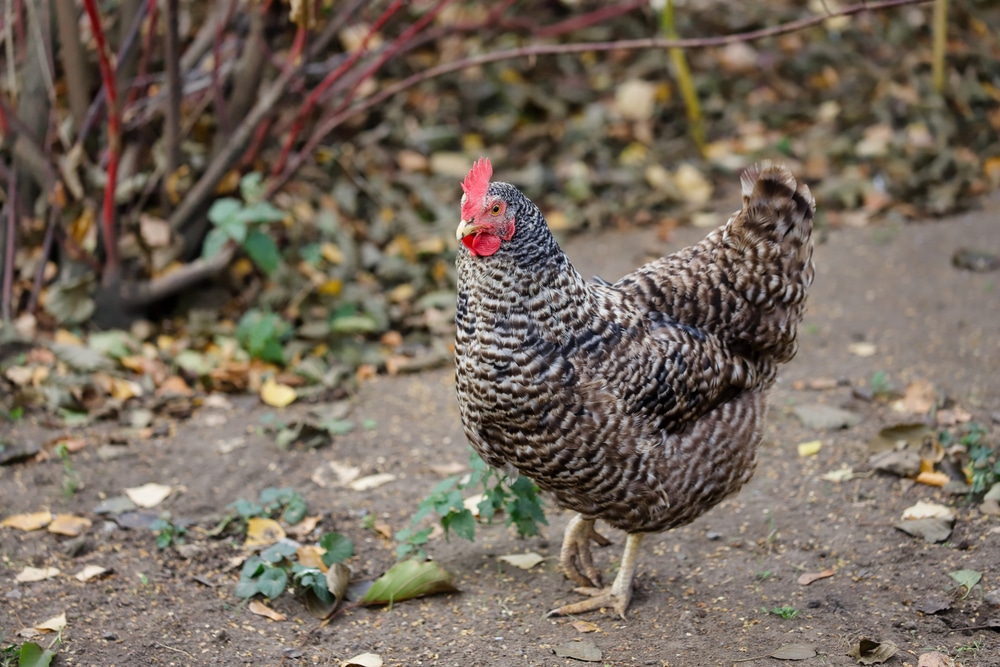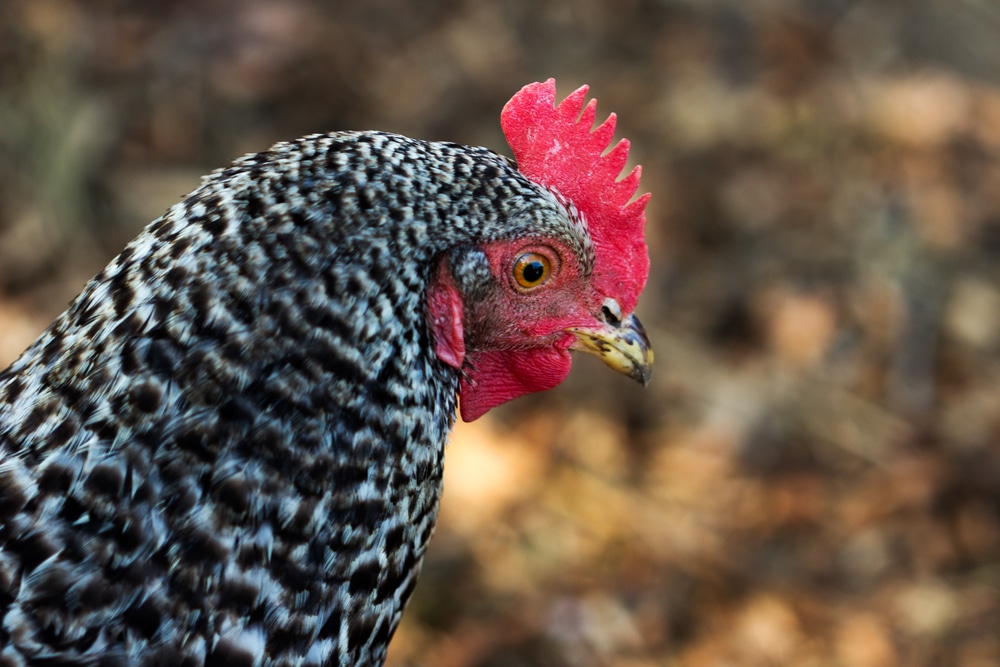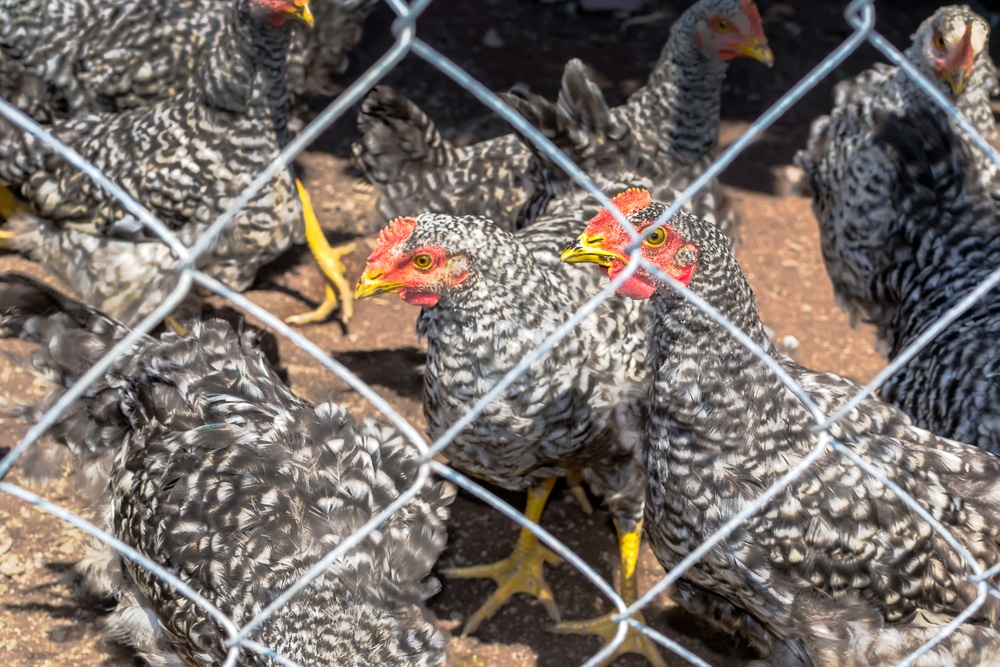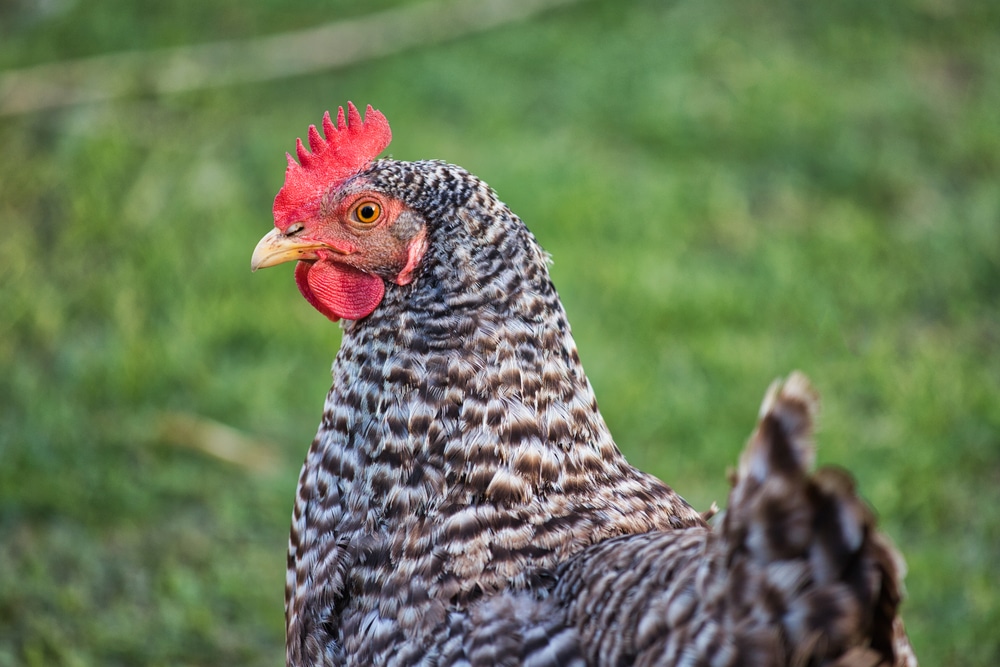Its name inspires images of the first settlers in the United States, a vision of patriotic wonder that can’t be ignored.
And true to that name, the Plymouth Rock chicken, one of the first chicken breeds to be raised in the United States, has a colorful history. Today, in fact, it’s one of the country’s most popular breeds of backyard birds.
Raised coast to coast prior to World War II, this chicken breed is an excellent source of both eggs and meat. As a dual-purpose bird, it surpasses almost every another breed in egg and meat production.
But is it the right chicken breed for you? Continue reading to learn everything you need to know about this illustrious breed.
History of the Plymouth Rock Chicken

The first ancestors of the Plymouth Rock chicken were first discovered in Massachusetts in 1849.
For about twenty years after their discovery, the chickens went dark, with historians unsure of why there are no records about these birds between 1849 and 1869.
However, in 1869, the Plymouth Rock suddenly reappeared. Bred in Massachusetts, the Plymouth Rock is believed to be a conglomerate of barred males and Java Hens.
The idea in breeding these two was that barred plumage, clean legs, and exceptional egg and meat production would result.
At the time, there was a great deal of confusion over the difference between rose and single comb birds. Both varieties were referred to as DOminiquies.
Eventually, in an effort to reduce this confusion, the New York Poultry Society designated all single-comb birds Plymouth Rocks and all rose-combed birds Dominiques.
Popular during World War II, raising the Plymouth Rock chicken was encouraged by the United States during the war.
This is because it was a great source of food to help support the troops who were fighting overseas as well as the families holding down the for back home.
Embraced by thousands of Americans during this time, the breed, unfortunately, fell out of favor after the war.
As chicken and egg production, like everything else at the time, became more mechanized, many breeds fell by the wayside.
Comercial breeds like the Cornish Cross and White Leghorn rose to the forefront, as they were considered much more productive than the humble Plymouth Rock.
Later, the Plymouth Rock was crossed with other breeds to create hybrids that were great at producing meat.
The chicken was one of the foundation breeds for the broiler industry and was (and currently is) also raised for genetic hackle to be used as a material in artificial fly construction for fishing.
For many years, as a result, it was difficult to find purebred Plymouth Rocks. Luckily, the chickens are making a comeback.
This is due in part to the Livestock Conservancy’s recognition of this breed as a rarer breed.
Today, the chicken breeds listed a recovering, with nearly a million birds believed to be in existence worldwide.
Appearance
The Plymouth Rock chicken is most easily identified by its barred plumage. It looks much like a prisoner with its black and white bars, and while males and females look quite a bit alike, there are some differences between the genders.
Males have black and white barring, with equal amounts of both. Each feather ends in a distinct dark tip.
Females, on the other hand, have black bars that are slightly wider than the white. While this can be difficult to see from far away, at a distance it may appear as though your Plymouth Rock hens are a darker grey in color.

While the barred Plymouth Rock is the most popular color variation of this chicken breed, it is certainly not the only one. This is the best known, prized in American culture and folklore.
This bird has a large triangular body that is sturdy with a full, wide breast and a long, broad back.
The feathers on this bird are loose and full, as well as exceptionally soft to the touch.
The barring pattern is a sharp black and white, especially when compared to a barred Dominique chicken that is fuzzier and grey in color.
The legs of this bird are clean, with four toes on each foot. Both the legs and skin are yellow, while the comb, wattles, and earlobes are red. The eyes are also red. The comb is single with five points.
These birds are prized for their size. On average, a hen will weigh about seven and a half pounds, while rooster will weigh close to ten pounds.
There’s also a bantam variety of the Plymouth Rock, although this is not nearly as common as the standard Plymouth Rock. Bantam Plymouth Rock hens are about two and a half pounds while males are slightly larger, at three pounds.
Admitted to the American Poultry Association in 1874, there are currently seven recognized varieties of the Plymouth Rock. Again, the Barred Plymouth Rock is the most popular, but other options include:
- Blue
- Buff
- Partridge
- White
- Silver Penciled
- Colombian
All varieties except the barred and white are quite difficult to find. In Great Britain, only Colombian, Barred, Buff, Black, and White varieties are recognized.
Although the Barred Plymouth Rock was the first to rise to popularity in the United States, it was quickly surpassed by the White Plymouth Rock in 1888.
It was created through selective breeding with the hopes that it would become a superior meat producing bird.
Although not nearly as attractive in its plumage and overall appearance as the Barred Rock, it is often used as a commercial meat producer.
Behavior
The Plymouth Rock is one of the most mellow birds you can raise. Not known for a nasty attitude or a tendency toward bullying behavior, the Plymouth Rock will get along well with every other member of your flock.
In fact, choose three words to describe this chicken, and owners will most often pick adjectives like “calm,” “docile,” and “sweet.” Even the roosters aren’t prone to aggression and will get along with other chickens, pets, and even small children.
Always curious and on the move, the Plymouth Rock will enjoy the freedom of free-ranging. It’s not a shy bird, either, and will happily follow you around the yard to see what kinds of treats you might have to offer!
That being said, the Plymouth Rock chicken can also tolerate confinement with ease. As long as you give each bird enough space, you shouldn’t have any issues confining this bird for reasonable amounts of time.
A great family bird, the Plymouth Rock is easy to trust and easy to manage. It will even get along with your dog, in most cases!
There is some natural variation among individuals in the breed, of course. While most people argue that these chickens are sweet, laidback, good-natured, and active, there are some chicken keepers who have claimed that their Plymouth Rock roosters can be bullies.
Plymouth Rock Chicken Productivity
In this section, we discuss egg and meat production of the Plymouth Rock Chicken.
Is the Plymouth Rock Chicken Good for Eggs?
Plymouth Rock chickens are often raised for egg production, averaging about 200 eggs each year or four eggs per week. These eggs are quite large and a pale brown color.
Unfortunately, their laying can be unpredictable as they reach older adulthood. For the first few years, your Plymouth Rock chickens will lay well. Starting around year three, you will notice that a gradual decline in productivity begins.
While this decline can be prevented by simple measures like avoiding the temptation to hang a light in your coop during the winter (which can burn your chickens out and reduce egg production in later years), keep in mind that laying ability is largely determined by genetics.
In fact, some Plymouth Rocks will lay well into their tenth year! There’s quite a bit of variability here.
Plymouth Rocks aren’t known for being broody, but it’s not unheard of, either. When you do have a Plymouth Rock hen becomes broody, she is apt to be a good sitter and an even better mother to her chicks.
Is the Plymouth Rock Chicken Good for Meat?
Plymouth Rock chickens feather out quickly and also mature rapidly.
By just eight to twelve weeks of age, your Plymouth Rock chickens are ready for butchering (although you can, of course, raise them longer for a heavier carcass).

If you want to fill your freezer, you really can’t go wrong with the Plymouth Rock. this chicken excels at meat production, with a deep full breast and a super meaty body. It has a good market weight, too, at an average of seven to eight pounds.
Today, this bird isn’t commonly raised exclusively for meat. However, it comprises on-behalf of the popular Cornish Cross broiler bird, which is the most popular commercial meat breed.
Health Issues of the Plymouth Rock Chicken
Plymouth Rocks aren’t known for any health issues in particular. They are healthy and exceptionally sturdy and aren’t bothered by any ailments in particular. As with all chickens, you will need to watch out for external and internal parasites.
External parasites are most easily prevented by inspecting your chickens on a regular basis.
Comb through the dense, fluffy feathering of your chickens to make sure bugs aren’t hiding among them. Providing your chickens access to a dust bath can help keep parasites like lice and mites away, and will also encourage natural socializing behaviors.
Internal parasites are uncommon but can be treated and prevented with clean, fresh food and water. You can also use natural dewormers, like apple cider vinegar, pumpkin seeds, and garlic to prevent these pests from popping up.
One other concern you will need to keep in mind is that Plymouth Rocks have large wattles and a single comb.
As with other single-combed chickens, these birds are more prone to frostbite in bitterly cold conditions.
Make sure your coop is draft-free yet also well-ventilated to help prevent moisture build-up, as this is the most common cause of frostbite.
Otherwise, you shouldn’t have too many issues with your Plymouth Rocks. They have great genetics as heritage breed chickens, and can usually live for at least ten years.
Some live as many as twelve or thirteen, and there are even records of birds living for an impressive twenty years! With the right care, this is possible for your chickens, too.
Pros and Cons of Raising Plymouth Rock Chickens
In this section, we discuss a few of the benefits and drawback of raising Plymouth Rock chickens.
Benefits of Raising the Plymouth Rock Chicken
A major benefit of the Plymouth Rock chicken is that it’s easy to keep if you have a family or other pets to worry about. Plymouth Rocks often become lap chickens, making this one of the most popular chicken breeds if you’re in the market for a pet chicken.
Although these birds are curious and naturally inquisitive, they are terrible flyers because of their heavy weights.
Therefore, you won’t need to worry about erecting a huge enclosure or fence to keep them in.
They aren’t likely to travel over to the neighbor’s yard if they need to fly to get there.
Plymouth Rocks are also known for being relatively quiet. Although they are talkative, emitting their standard egg songs and morning crows, they do so at a low volume and aren’t likely to disturb your neighbors.
An easygoing chicken breed, the Plymouth Rock is easy to care for, especially for beginners.
Even if you make a few mistakes here or there while you are getting started, this breed is very forgiving. They can more or less raise themselves!
They also have some beautiful plumage. Although there are many choices, including brown and white and buff, without a doubt the most unique and most popular choice is barred. With a bold look, these chickens will stand out sharply in your chicken yard.
With a mellow temperament and a gorgeous appearance, the Plymouth Rock is the perfect chicken for exhibition as well as for 4H projects, if you have children.
Challenges of Raising the Plymouth Rock Chicken
There are very few challenges to speak of when it comes to raising the Plymouth Rock chicken. Most have to do with the weather.
Although these birds can be raised in just about any climate, you will want to keep an eye out and be prepared for temperature extremes. If the weather is too cold, your birds can fall victim to frostbite. If it’s too warm, they can become overheated.
Make sure your Plymouth Rocks have access to a coop that is warm and draft-free in the wintertime, yet ventilated in the summer. They will also need plenty of shade and fresh, clean water during all seasons, too.
Due to their size, you may have some flock dynamic issues in your coop, but this is unlikely.
Plymouth Rocks can easily push around chickens in the flock, using their heft to get what they want. This usually only appears at mealtime and is easy to avoid by providing your birds with plenty of feeder choices.
The same traits can manifest as stubbornness, too, so just keep this in mind.
How to Raise the Plymouth Rock Chicken

While Plymouth Rocks aren’t known for being exceptionally broody, if you’re lucky enough to have a Plymouth Rock hens go broody, you’ll find that she’s a great mother. When you’re raising your own Plymouth Rocks, it’s your best bet to have a hen goes broody, but you can also incubate your own eggs.
While you will need to feed a chick starter for the first ten weeks or so, you can then move on to a standard adult feed.
The Plymouth Rock does not have any specific dietary requirements, but if you’re raising your birds primarily for eggs, you will want to either use an egg layer feed or add some extra calcium with crushed-up eggshells or oyster shell.
Layer feed will provide all the nutritional requirements your chickens need, but if you’re raising a mixed flock that includes roosters, you’re better off using an all-purpose broiler feed.
This will have all the protein your flock needs, minus the calcium. Too much calcium can be damaging for an adult rooster’s kidneys and liver.
Instead, you can feed a broiler feed to all of your birds and then provide free-choice oyster shell separately. Your hens will eat the calcium from this separate feeder when they need it.
As with all other chicken breeds, you’ll also need a secure, safe coop. Make sure you have plenty of nesting boxes (at least one for every four chickens) along with large perches since these chickens are larger than normal.
Make sure the coop is well-ventilated to keep them cool in the summer and warm in the winter.
Is the Plymouth Rock Chicken Right For You?
While it’s unclear what the specific origins of the Plymouth Rock chicken might be, one thing is for sure – this could very well be the best chicken for you. This chicken is suitable for a family and can handle both confinement and free-ranging with ease.
Although the Plymouth Rock fell by the wayside after World War II, it is gradually regaining popularity as more people develop interests in raising heritage breed chickens.
There are lots of benefits to raising heritage breeds -especially dual-purpose breeds that are hardy in a variety of circumstances.
While the White Plymouth Rock is the most popular in commercial settings, it’s not difficult to find Barred Rocks at a hatchery or farm supply store near you, either.
These chickens are often raised by small family farms and homestead operations, so they’re available at a reasonable price just about everywhere.
As a fantastic backyard bird, Plymouth Rocks offer excellent meat and egg production. Plus, they’re friendly and easy to care for. What more could you want? This chicken breed is the perfect choice for just about anyone.
